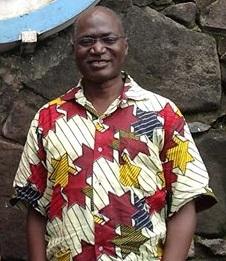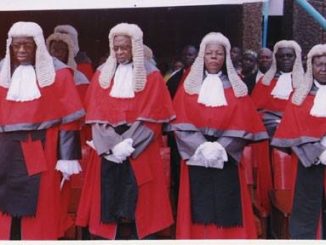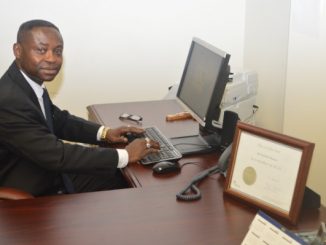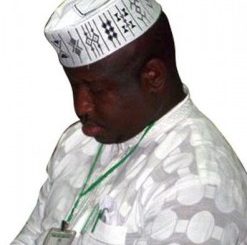
August 16, 2014: While President Ernest Bai Koroma was hosting an ‘Ebola Press Conference’ in State House, Freetown, Sierra Leone born and bred film producer, owner/manager of B-Trixx film productions, ‘cyber journalist’, Jaime Yaya Barry, was guarding two international journalists into the epicenter of the Ebola Outbreak in Sierra Leone, Kailahun District. The journalist were Samuel Aranda of the National Geographic magazine, one of the most widely-read and credible magazines in the world; and Ben Solomon of the New York Times, about the most influential newspaper among the cream of United States’ elite.
Ebola is one of hottest international news today
The Ebola Outbreak in Guinea, Liberia, and Sierra Leone has been one of the biggest and hottest stories on ALL powerful globally-highly-rated print and electronic media over the past two months. Like bloodhound, they are just two of the international journalists following the ‘blood trail’ of Breaking News into the three Mano River Countries. On August 28, 2014, I spoke briefly with the cerebral Special Adviser to the President for Research, Dr. Mohamed Gibril Sesay, in his office at State House (he is also part of the new Communications Committee of the Ebola Operations Command), and he was emphatic that the big challenge to win the Ebola War is….”details…details…details…”; a daunting challenge he said, because too many Sierra Leoneans are inclined to be “generalists….superficial….”, and almost always would ignore details; while the Ebola Situation demands “details” at all levels of the chain – from suspecting a person has the Ebola virus, to diagnosing the person….quarantine of the person…; and, where necessary…identifying those who have come in contact with the infected person…; burial of a person struck dead by the Ebola virus…..disinfecting….sterilizing medical equipments, etc. “Each mistake in details in any of this chain could mean disaster”, Dr. Sesay said, his tone rising, atypically. In the following paragraphs as I bring out details of someone just from the ‘Ebola Frontline’, I ask that we all reflect on Dr. Sesay’s words…
At about 10.00 am, Jaime and the National Geographic and New York Times journalists left the Red Cross center at Kailahun Town, which is like the Ebola Operational Command Center in the district. . The two foreign journalists, Samuel and Ben, were in one Toyota Pathfinder; and, Jaime rode alone with a driver in another Toyota Pathfinder. They were travelling to a ‘potential Ebola burial case’ with a team of ‘Ebola burial team’. They were six of them in a Nissan Pathfinder jeep; there was another open back jeep accompanying them for the ‘suspected Ebola corpse’. The vehicles were on rental to the Red Cross for $100 a day; there were few people willing to rent their vehicles to the Red Cross to bury ‘actual or real Ebola fatalities’. One of the few people who was willing to rent out his vehicle for Ebola burials pulled it out after a single day the vehicle was used to bury six ‘Ebola Victims’. The man feared ‘bad luck’ on his vehicle. Jaime, the foreign journalists, and the Ebola burial team went to a village called Jojoima, two hours drive from Kailahun Town, on one of the worst roads in sub-Saharan Africa.
Anybody who dies in Kailahun is treated like an ‘Ebola suspect case’
Four days earlier, a report had been made of a woman aged 83 years who had died in Jojoima. There is a RECENT ‘Ebola law’ in Kailahun that ALL cases of death would be treated as ‘Ebola suspect cases’; and NO ONE should bury any corpse, except a report had been made in the Ebola Center in Kailahun Town; and ONLY the Ebola burial team should be doing ALL burials in Kailahun, Jaime was told. The Ebola burial team were only able to respond to the call from Jojoima four days after they had been called; and that was coincidentally when the journalists arrived – because they were busy in other villages, burying corpses.
When the journalists arrived in Jojoima they met the corpse already buried – in violation of the ‘new Ebola law’ on burials. The reason the villagers gave was the corpse was already getting rotten, as they had no morgue, or, ice, or, anything to preserve the corpse with. The ‘Ebola burial team’ simply turned back, and went to Daru… They didn’t interview anyone. They didn’t do any investigation as to what would have happened. They simply promised the villagers that they would return, and exhume the body; and do their investigation as to whether the death of the woman was caused by the Ebola virus. The village is in an area where it is difficult to get ‘network’ to use one’s mobile phone. Villagers have to move out of the village, and climb a hill to telephone outside of the village. The Ebola burial team learned that the corpse of the deceased woman had been washed, and clothed. But, they didn’t bother to make contact with those who had washed the corpse.
The Ebola Burial Team are Treated Worst than Lepers in Kailahun
Jaime spoke with the leader of the burial team, Daniel James, and one other man, called Kandeh Kamara. They were all in the 20s. They were being paid Le60,000 daily for their work – a work disdained and feared by villagers who have made them a pariah among their own families. No one wants them around!! They would be laughed at, and shunned, even within Kailahun Town. It was difficult for them to get any place to rent, as everyone in the town fears them – ‘the Ebola boys’. Why have they taken the job which is so much reviled by others in the township? Survival!! School boys who could barely earn Le50,000 a month doing any job in the district were now earning about Le1,200,000 monthly doing ‘Ebola burials’.
From Jojoima, they moved back to Daru, and fueled their cars, then, travelled to Gbekie, in Jwalahun Chiefdom. They went to the house where the corpse of a former nurse, Hawa Ansumana, was laid. She has a partial stroke three years before she died.
The villagers had washed the corpse of a ‘suspected Ebola case’; touching it….; wailing!!
Before the burial team went to take the corpse for burial, they dressed up in their now ‘feared’ ‘Ebola protective clothing’. While they were dressing up, about five women rushed in and out of the verandah room where the corpse was, carting out mattresses, pillow cases, buckets, bowls, etc. They wanted to protect these items from being ‘infected’ by the Ebola burial team. At the door of the room where the corpse laid were seated two young men – who were said to be two of the sons of the deceased. They also would move in and out of the room, wailing, and gnashing teeth; and, would be consoled by other villagers, hugging them.
The ‘Ebola burial team’, fully clad in their bright yellow and turquoise space-ship-like suits, then went into the room where the corpse was…Spraying everywhere. They put the corpse into a body bag, and on to the open back vehicle. A huge crowd of villagers followed the corpse to the cemetery. Those who had been moving in and out of the room where the ‘suspected Ebola case’ was were being hugged, embraced, and consoled.
….
The eldest son of the deceased woman, Ansumana Yusuf, told Jaime that their mother had been accused for long for being a witch. As a nurse, and a midwife in the area, most often than not, when she would try to bring a baby into the world, the baby would die. They said the luck of the deceased woman ran out when she assisting a woman to deliver her baby – a woman who had been given exceptionally powerful charm by a renowned ‘fetish man’ in the area. So, the deceased was ‘destroyed’ by a charm before she could put witchcraft on the baby she was about to deliver. Jaime asked Ansumana whether he had touched the corpse of her mother; and he said “yes”.
While the foreign journalists were talking photographs, Jaime had to pass on vital information on how Ebola would be spread to Ansumana and other villagers within earshot. The Ebola burial team had not bothered to talk with the villagers.
When Jaime and the foreign journalists were back at the Luawa Resort in Kailahun Town, Ansumana called to ask whether it was safe for them to sleep in the room which had been sprayed by the Ebola burial team. It was Jaime who had to telephone the Red Cross to relay Ansumana’s question. Jaime was told that it would be safe after twenty four hours. He passed the information back to Ansumana. Before the day ended, Ansumana called back and told Jaime that the family of the deceased had decided not to use the house at all – not convinced by what the Ebola burial team had told them.
Hyper-Ebola Awareness in Kailahun Town!! “Don’t Touch” is said by everyone
Jaime told me that there appeared to be hyper Ebola awareness in Kailahun. He said that it appears as if everyone, young and old, children and market sellers, would utter the English words, “Don’t touch” – when you get a bit close to them. No one is shaking hands in Kailahun Town. All the public places – cinemas, nightclubs, etc. – have been shut down. There are hordes of youth and children moving from house to house doing Ebola sensitization. They appeared oblivious of any incentives from the central government for them to do such sensitization. It was not like that when there was the first Ebola outbreak about four months ago.
Then, the first Ebola victims who were vomiting blood, and exuding blood from their noses, were said to have suffered a ‘witchcraft attack’. The chief of Daru was actually implored by the people to make special sacrifices to ward off the suspected witchcraft attack.
There appear to be only two Ebola burial teams in the entire Kailahun District. I wonder whether they are equipped to put into motion the detail….detail…detail….which Dr. Mohamed Gibril Sesay said would be vital for success in the Ebola War. I wonder what the National Geographic magazine and New York Times journalists would write about what they saw in Kailahun this August.




Leave a Reply